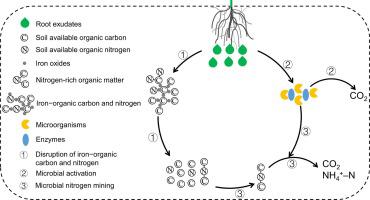Geoderma ( IF 5.6 ) Pub Date : 2020-12-21 , DOI: 10.1016/j.geoderma.2020.114877 Zhenhui Jiang , Yizhen Liu , Jingping Yang , Philip C. Brookes , Anna Gunina

|
The effect of living roots on the co-mineralization of soil organic carbon (SOC) and nitrogen (SON) and driving mechanisms of the rhizosphere priming effect (RPE) remains unclear. Moreover, it is still poorly understood whether the abiotic mechanisms, whereby roots accelerate soil organic matter (SOM) loss by destabilizing organo-mineral associations, are involved. Biotic and abiotic processes involved in the RPE and gross N mineralization (GNM) were investigated using three paddy soils (C3) under maize (C4 plant) cultivation. The soils had high and low total N (1.79 and 3.3 g kg−1 soil) as well as iron- (Fe-) (hydr-) oxide (1.1 and 2.2 g kg−1 soil) contents, which gave the following combinations: high-Fe/low-N, low-Fe/low-N, and low-Fe/high-N. The RPEs and GNM were measured using a 13C-natural abundance approach and 15N-pool dilution technique, respectively, on day 86 of maize cultivation. Living roots enhanced native SOC mineralization by 70.4–204% and GNM by 118–382%. As expected, biotic mechanisms contributed to RPEs (‘microbial activation’ and ‘microbial N-mining’) that was supported by the increase of soil microbial biomass C and extracellular enzyme activities in presence of plant, and the lower C/N ratio of primed SOM than the original SOM in unplanted soils. Higher RPEs and relative primed N mineralization via stronger ‘microbial N-mining’ were found in low-Fe/low-N vs low-Fe/high-N soils. In contrast to expectations, the RPEs and relative primed N mineralization were greater in high-Fe/low-N versus low-Fe oxide soils. The strongest decrease in SOM-derived Fe-bound C and increase in root-derived Fe-bound C were observed in the high-Fe soil, because root exudates liberated more C from Fe-bound SOM and co-precipitated with Fe oxides. This shows that the abiotic process was involved in RPEs whereby root exudates promoted soil C loss by releasing it from Fe-organic complexes. Thus, this study demonstrated that coupled biotic-abiotic processes could regulate RPEs.
中文翻译:

根际启动调节土壤有机碳和氮矿化:非生物机制的意义
尚不清楚生根对土壤有机碳(SOC)和氮(SON)共同矿化的影响以及根际启动作用(RPE)的驱动机制。此外,人们还不清楚是否涉及非生物机制,即根系通过破坏有机矿物质的结合来加速土壤有机质(SOM)的损失。研究了在玉米(C 4植株)下种植的三种水稻土(C 3)对参与RPE和总氮矿化(GNM)的生物和非生物过程的影响。土壤的总氮含量高和低(分别为1.79和3.3 g kg -1)和氧化铁(Fe-)(水)氧化物(1.1和2.2 g kg -1)土含量),从而得到以下组合:高铁/低氮,低铁/低氮和低铁/高氮。RPE和GNM使用13 C自然丰度方法和15玉米栽培第86天分别采用N池稀释技术。活根使天然SOC矿化提高了70.4–204%,GNM增强了118–382%。正如预期的那样,生物机制促进了RPE(“微生物活化”和“微生物N挖掘”),这是由植物存在时土壤微生物生物量C和细胞外酶活性的增加以及引发的较低C / N比所支持的SOM比未种植土壤中的原始SOM高。在低铁/低氮与低铁/高氮的土壤中发现了更高的RPE和通过更强的“微生物氮开采”引起的相对引发的氮矿化。与预期相反,高铁/低氮土壤中的RPE和相对引发的N矿化比低铁氧化物土壤中的更高。在高铁土壤中观察到SOM衍生的Fe结合的C减少最强,而根衍生的Fe结合的C增加最明显,因为根系分泌物从结合Fe的SOM中释放出更多的C,并与Fe氧化物共沉淀。这表明非生物过程参与了RPE,其中根系分泌物通过将其从铁有机配合物中释放而促进了土壤C的损失。因此,这项研究表明,生物-非生物耦合过程可以调节RPE。

































 京公网安备 11010802027423号
京公网安备 11010802027423号